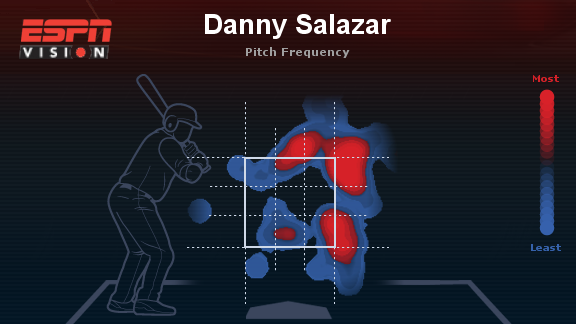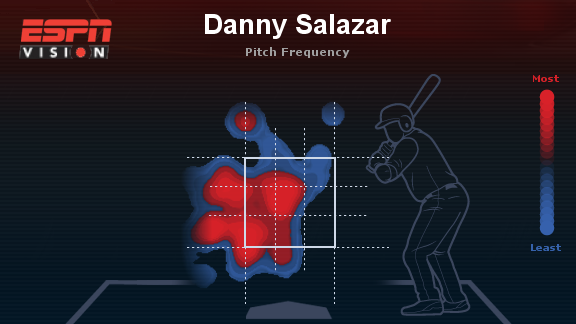A few starts ago, I mentioned that the Indians may end up sending Danny Salazar down to the minors eventually. At the time, both he and Carlos Carrasco were struggling in the rotation; the only difference was that Salazar still had minor league options remaining. Even though the Indians moved Carrasco to the bullpen and called Josh Tomlin up to take his place in the rotation, I still thought that Salazar’s spot in the rotation could be in danger. With Trevor Bauer doing well at Triple-A, it gave the Indians an option if they wanted to make a move. Over his past couple of starts, Salazar seemed to show some improvement. However, after a shaky outing last night in Toronto, and yet another early exit from the game, the Indians sent him to Columbus.
What exactly was going wrong for Salazar this year, when compared to his strong debut during the 2013 season? First of all, his BABIP was significantly higher in 2014. His 2013 BABIP total was .298, while his 2014 BABIP total was .369 So there is a bit of bad luck involved with this, although that’s far from the only culprit.
Salazar’s walk rate also increased in 2014. His BB/9 in 2013 was 2.60, while in 2014 it was 3.76. He still had a good number of strikeouts this year, but still at a lesser rate from 2013. His K/BB ratio went from 4.33 last year, to 2.76 this year. His overall strkeout rate went from 30.8% in 2013, to 25.5% in 2014, while his walk rate went from 7.1% in 2013, to 9.2% in 2014. Even when Salazar was doing “okay” he was still throwing an inordinate amount of pitches, which led to early exits from games via pitch count.
Next, let’s look at ground ball and fly ball percentages. While Salazar’s ground ball percentages are roughly the same (34.4% in 2013 vs. 33.3% in 2014) his fly ball totals have gone up. He went from a fly ball percentage of 39.8% in 2013, to a fly ball percentage of 45.3% in 2014. His home run to fly ball ratio shot up to 15.1% in 2014, compared to 13.7% last year. The one total that really spiked was his infield hit ratio (which could be connected to the high BABIP numbers). His infield hit percentage was 4.5% in 2013, but went all the way up to 15.4% in 2014.
Another interesting point about Salazar has to do with the types of pitches he’s thrown, along with a drop in his average velocity in all pitch types across the board. For example, he threw his fastball 68.5% of the time in 2013, for an average velocity of 96.2 mph. So far in 2014, he’s thrown his fastball 76.4% of the time, with an average velocity of 93.6 mph. So he’s going to his fastball more often, and it’s a bit slower than it was last year.
Salazar used his slider 11% of the time in 2013, with an average velocity of 86.8 mph. In 2014, he used his slider just 6.7% of the time, and it had an average velocity of 84.8 mph. So even it lost a couple of mph from last season. He used his change-up 20.6% of the time in 2013 and it had an average velocity of 85.8 mph. In 2014, he used it 16.6% of the time, and it had an average velocity of 83.2 mph. You know the drill by now – used it less, plus it had less velocity. The only pitch that stayed almost the same was his curveball – he used it just 0.3% of the time in 2013, and it had an average velocity of 78.5 mph. He used it 0.1% of the time in 2014, and the velocity remained the same; his only pitch that didn’t see a drop in speed.
Let’s look at a few other things that Danny Salazar is doing worse this year (there are a lot of them). In 2013, he got batters to swing at pitches outside the strike zone 35.8% of the time. That fell to 28.7% this year. Batters are making contact with his pitches at a much higher rate in 2014 as well.
As far as pitch location, I tried to pull up a few different heat maps to see if there were any major differences. Ryan looked at Salazar’s fastball placement back on April 18, but these maps represent all types of pitches from each start. I tried to get a couple of good and bad starts – the first two maps break down lefties and righties in Salazar’s first major league start last year on July 11. Then I took a poor start against the Royals on April 22 this year, as well as what was probably his best start of 2014 – April 27 against the Giants. The last set are from last night’s game against Toronto.

Against left-handed hitters, first major league start on July 11, 2013. Allowed 1 ER on 2 hits in 6 IP.

Salazar against left-handed hitters on April 22, 2014 against the Kansas City Royals. He gave up 4 ER on 7 hits in just 4.1 IP.

Salazar against left-handed hitters on April 27, 2014 against the San Francisco Giants. He gave up just 1 ER on 5 hits over 7 IP.
Heat maps courtesy of ESPN Stats & Information
When Salazar has been successful, he’s kept the ball away from left-handed hitters. In the one bad start on April 22, you can see that he was just all over the place to both sides of the plate. By last night’s start, he kept the ball away from lefties at times; a lot of pitches still happen to be right down the middle of the plate.
When you take all of the above data, you can see that Salazar is relying more on his fastball in 2014, and that all of his pitches have lost some velocity. With an increase in walk rate, he’s often either all over the place (like April 22) or the pitches are coming down the middle of the plate. If hitters have figured out what he’s doing, they just have to sit back and wait for their pitch.
So after all of this, who will take Salazar’s spot on the roster? Kyle Crockett, a pitcher from Double-A Akron who has 6 saves and an 0.57 ERA so far this season with the Rubber Ducks. Crockett was the Tribe’s fourth-round selection in the 2013 draft, and he becomes the first person from last year’s draft class to make the majors. There will likely be another roster move by the time Salazar’s spot in the rotation approaches (I doubt they’re going to re-start the Carrasco-in-the-rotation experiment). So Crockett provides an extra bullpen arm in the meantime, and gives the Indians a chance to see what he can do at the major league level.








Let’s just say it: it is now quite clear that “experiment” of cutting Ubaldo and Kazmir loose and depending on Salazar and Carrasco was about as unambiguous a failure as it could have been. I remain quite happy we didn’t pay Ubaldo (even if he succeeds in having a good year he wasn’t worth it), but I can’t wrap my mind around the logic of not paying Kazmir a relative pittance to stick around. When a small-market ball club renowned for it’s discernment grabs your cast off, it should tell you something.
The ‘relative pittance’ you mention is just revisionist history. Kazmir had one slightly above average season after basically being battered for four years. The contract he signed with Oakland would have made him the highest paid pitcher on the Indians by more than $1 million per year and would have added nearly 35% to the pitching budget. That just wasn’t in the cards. The Indians just didn’t trust that one year sample as much as the A’s did.
The A’s are head and shoulder better run than the Indians…
Shaponetti needs to get a clue.
Yeah, it’s easy in retrospect to say that they should have expected him to have a huge year, but I was surprised by the contract signing the A’s made. Oh well, you can’t win ’em all.
An argument can be made for not keeping Ubaldo, for not keeping Kazmir, and even for not keeping Harang. But collectively, those three decisions essentially turned 2014 into a rebuilding/developmental year. Salazar and Bauer may be excellent pitching prospects with bright futures, but neither was ready on opening day to headline a playoff rotation and going with Carrasco was a reckless gamble. Our offense is not nearly good enough to carry unproven starters in the rotation and stay over .500. Throw in the hugely disappointing play of our big money position players and epically bad defense of historical proportions, and last place was a virtual certainty. A fire sale looms.
Last year was a fluke. This year is exactly what they are. A slightly under .500 team. They have no power, no consistent starting pitching (outside of Kluber), and the worst defense in baseball. They are the same team as last year…
…with less pitching, less speed, and less power. Yet, the FO sold the fans on that this was “unfinished business” – laugh. The Indians NEVER do business. They lie, repeatedly – to the fans. I don’t get it. Why do the Cleveland fans keep letting the Dolans get away with this? They made $30M in 2012, who knows what they made last year…